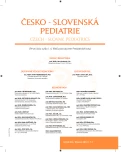Cryptorchidism – the need of early diagnostics and treatment
Authors:
M. Michalisko; M. Vidiščák; E. Dobríková; J. Novotný; R. Koreň; E. Murár
Authors‘ workplace:
Klinika detskej chirurgie SZU, Detská fakultná nemocnica s poliklinikou, Banská Bystrica
prednosta prof. MUDr. M. Vidiščák, PhD., FEBPS
Published in:
Čes-slov Pediat 2014; 69 (1): 29-38.
Category:
Reviews
Overview
Cryptorchidism is the most common congenital anomaly of the male genitalia meaning the absence of testicles in the scrotum. Approximately 5% of full-term newborn males have undescended testicle, at the age of 12 months it is only 1%. As in the 6th month there starts a decrease of germ cell count and the spontaneous descent after this age is rare, the therapy of cryptorchidism should start already at this age and should be completed until the age of 18 months. If the testicle is palpable the orchidopexy from the inguinal approach is indicated. If the testicle is unpalpable the diagnostic laparoscopy is indicated. If a low intra-abdominal testicle is found, one-stage orchidopexy without transection of testicular vessels is possible, if a high intra-abdominal testicle is found one or two stage orchidopexy with the transection of testicular vessels is performed.
At the present time the postoperative hormonal treatment becomes significant in the treatment of the cryptorchidism and may have a beneficial effect on fertility. The hormonal treatment is still controversial and has many opponents despite the positive influence on the fertility, yet it is still not a standard treatment for cryptorchidism.
Key words:
cryptorchidism, consequences of cryptorchidism, treatment of cryptorchidism
Sources
1. Zeman L. Retence varlete. In: Šnajdauf J, et al. Dětská chirurgie. 1. vyd. Praha: Galén, 2005: 272–276. ISBN 80-7262-329-X.
2. Kolon TF. Cryptorchidism. In: Docimo SG, Canning DA, Khoury AE, et al. Clinical Pediatric Urology. 5th ed. Abingdon: Informa Healthcare UK Ltd, 2007: 1295–1307. ISBN 1841845043.
3. Bianchi A. The undescendent testis. In: Burge DM, Griffiths DM, Steinbrecher HA, Wheeler RA, et al. Paediatric Surgery. 2nd ed. London: Hodder Education, 2005: 311–319. ISBN 0 340809108.
4. Hutson JM. Cryptorchidism. In: Puri P, Höllwarth M, et al. Pediatric Surgery: Diagnosis and Management. 1st ed. Berlin: Springer-Verlag, 2009: 919–926. ISBN 978-3-540-69559-2.
5. Ong C, Hasthorpe S, Hutson JM. Germ cell development in the descended and cryptorchid testis and the effects of hormonal manipulation. Pediatr Surg Int 2005; 21: 240–254.
6. Ritzén EM. Undescended testes: A consensus on management. Eur J Endocrinol 2008; 159: 87–90.
7. Hušťavová L, Michalka P. Retentio testis. In: Vidiščák M, et al. Novorodenecká chirurgia I. 1. vyd. Krivá: M-service, 2008: 57–62. ISBN 978-80-969978.
8. Hušťavová L. Hydrocele testis, hydrocele funikuli spermatici. In: Vidiščák M, et al. Novorodenecká chirurgia I. 1. vyd. Krivá: M-service, 2008: 62–63. ISBN 978-80-969978.
9. Gapany CH, et al. Management of cryptorchidism in children: guidelines. Swiss Med Wkly 2008; 138, č. 33–34: 492–498.
10. Kočvara R. Kryptorchizmus: kdy načasovat a jakou léčbu provést? Urologicke Listy 2007; 5 (1): 30–33.
11. Chung E, Brock GB. Cryptorchidism and its impact on male fertility: a state of art review of current literature. Can Urol Assoc J 2011; 5 (3): 210–214.
12. Li YX, Coucke PA, Qian TN et al. Seminoma arising in corrected and uncorrected inguinal cryptorchidism: treatment and prognosis in 66 patients. Int J Radiat Oncol Biol Phys 1997; 38 (2): 343–350.
13. Forman D, Pike MC, Davey G, et al. Aetiology of testicular cancer: association with congenital abnormalities, age at puberty, infertility, and exercise. BMJ 1994; 308:1393–1399.
14. Pettersson A, Richiardi L, Nordenskjold A, et al. Age at surgery for undescended testis and risk of testicular cancer. N Engl J Med 2007; 356 (18): 1835–1841.
15. Docimo SG, Silver RI, Cromie W. The undescended testicle: Diagnosis and management. Am Fam Physician 2000; 62 (9): 2037–2044.
16. Hušťavová L. Varicocele. In: Vidiščák M, et al. Novorodenecká chirurgia I. 1. vyd. Krivá: M-service, 2008: 64–65. ISBN 978-80-969978.
17. Lisá L. Nesestouplá varlata. Čes-slov Pediat 1996; 51: 235–237.
18. Dunkel L, Taskinen S, Hovatta O, et al. Germ cell apoptosis after treatment of cryptorchidism with human chorionic gonadotropin is associated with impaired reproductive function in the adult. J Clin Invest 1997; 100 (9): 2341–2346.
19. Schwentner C, Oswald J, Kreczy A, et al. Neoadjuvant gonadotropin-releasing hormone therapy before surgery may improve the fertility index in undescended testes: a prospective randomized trial. J Urol 2005; 173 (3): 974–977.
20. Hadziselimovic F. Successful treatment of unilateral cryptorchid boys risking infertility with LH-RH analogue. Int Brazilian J Urol 2008; 34 (3): 319–328.
21. Hutson JM. Undescendent testes. In: Stringer M, Oldham KT, Mouriquand PDE, et al. Pediatric Surgery and Urology: Long-term Outcomes. 2nd ed. Cambridge: Cambridge University Press, 2006: 652–663. ISBN 0-521-83902-5.
22. Ludwikowski B, González R. The controversy regarding the need for hormonal treatment in boys with unilateral cryptorchidism goes on: a review of the literature. Eur J Pediatr 2012, dostupné na internete: http://www.springerlink.c om/content/v7x3575708731085/fulltext.pdf.
23. Docimo SG. The results of surgical therapy for cryptorchidism: a literature review and analysis. J Urol 1995; 154 (3): 1148–1152.
24. Drlík M, Kočvara R. Nehmatné varle u dítěte: začít diagnostickou laparoskopií nebo otevřenou revizí třísla? Česká Urologie 2011; 15 (2): 101–107.
25. Franco I. Management of impalpable testes. In: Najmaldin A, Rothenberg S, Crabbe S, et al. Operative Endoscopy and Endoscopic Surgery in Infants and Children. 1st ed. London: Hodder Arnold, 2005: 385–390. ISBN 0 340 80725 3.
26. Frank JD, Geahart JP, Snyder HM. Operative Pediatric Urology. 2nd ed. London: Churchill Livingstone, 2002: 260–270. ISBN 0-443-05358-8.
27. Esposito C, et al. Long-term outcome of laparoscopic Fowler-Stephens orchiopexy in boys with intra-abdominal testis. J Urol 2009; 181 (4): 1851–1856.
Labels
Neonatology Paediatrics General practitioner for children and adolescentsArticle was published in
Czech-Slovak Pediatrics

2014 Issue 1
Most read in this issue
- Cryptorchidism – the need of early diagnostics and treatment
- Transient pseudohypoaldosteronism – „puzzle“ of pediatric nephrology and urology
- The care of prematurely born child: when to begin and end?
- Adipsic diabetes insipidus in a child with dysgenesis of corpus callosum
